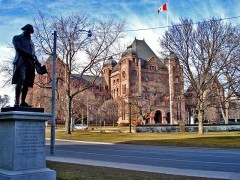The property tax is actually a combination of two taxes: one on the land and one on the buildings, but there are multiple benefits to urban design when municipal property taxes are split in two and shifted off buildings and onto land value alone. When municipalities collect a percentage of the community-created land value (economic rent), instead of taxing improvements (buildings), walkability and infill occur naturally, reducing municipal taxes and improving the quality of life for all. By employing economic rent capture as a market mechanism, municipalities can generate sufficient revenue plus achieve policy goals without coercive regulations and punitive actions.
A revenue-neutral tax shift off buildings and onto land value:
* Encourages efficient and intensive land use since taxes remain the same whether land is vacant or if it is used productively.
* Reduces the amount of vacant land and parking lots since it becomes more expensive to sit on undeveloped or poorly developed land.
* Reduces land speculation since waiting till the price of land rises will be more expensive.
* Improves housing stock and rental units since improvements, renovations, and additions do not incur increased taxation.
* Increases the amount of affordable housing without subsidies since builders can avoid higher land costs by building efficiently on small lots (row houses, low-rise, semi-detached).
* Reduces suburban sprawl since land-inefficient greenfield developments incur higher land taxes relative to more land-efficient infill.
* Eliminates the costs, inaccuracy and complexity of assessing improvements. Assessing land alone is a simple and inexpensive process.
* Reduces speculative land bubbles since more of the unearned increment that accrues to land is captured to finance city programs instead of flowing to land owners.
Furthermore, collecting community-generated upkick in land value is the best way to finance infrastructure. Any infrastructure that increases land values should be funded through the collection of the increased economic land rent generated by that infrastructure, whether it is a hospital, school, sewer upgrade, park or transit system.
Normally the increased economic rent goes (untaxed) to the person or company that owns affected land, instead of to the taxpayers who paid for it. Taxpayers everywhere are unjustly expected to pay for improvements that only benefit the local land-owning minority.
If infrastructure is warranted and beneficial it will raise the value of their land by more than the cost of that infrastructure. When publicly funded redevelopment makes locations more desirable, more economic rent is attracted, over time, than the cost of the initial redevelopment.

